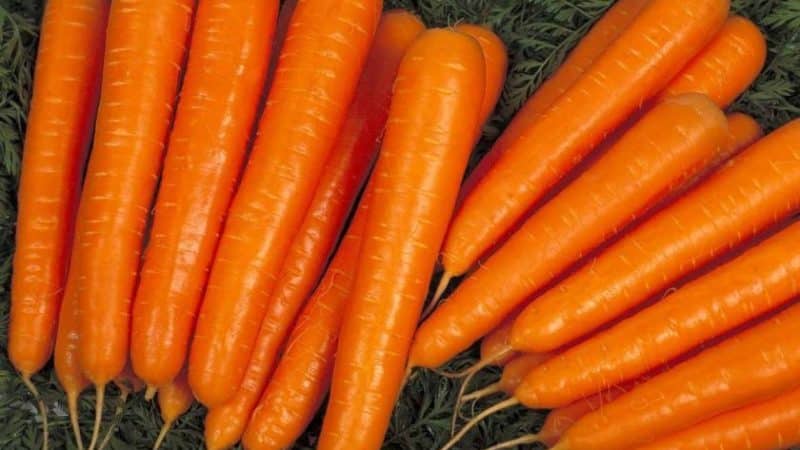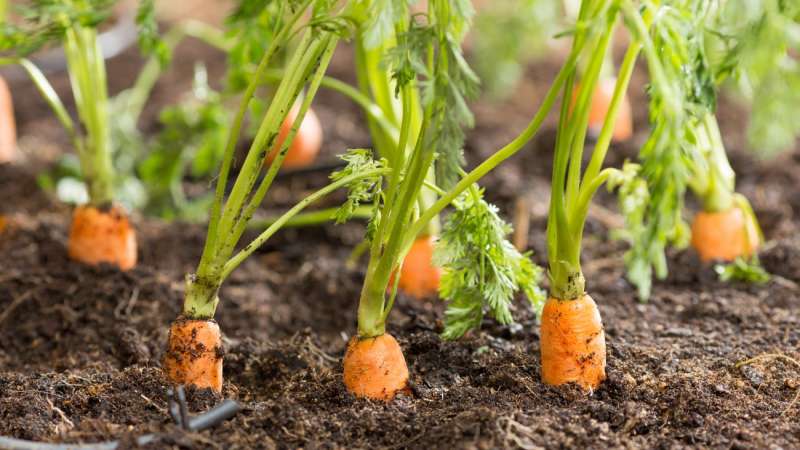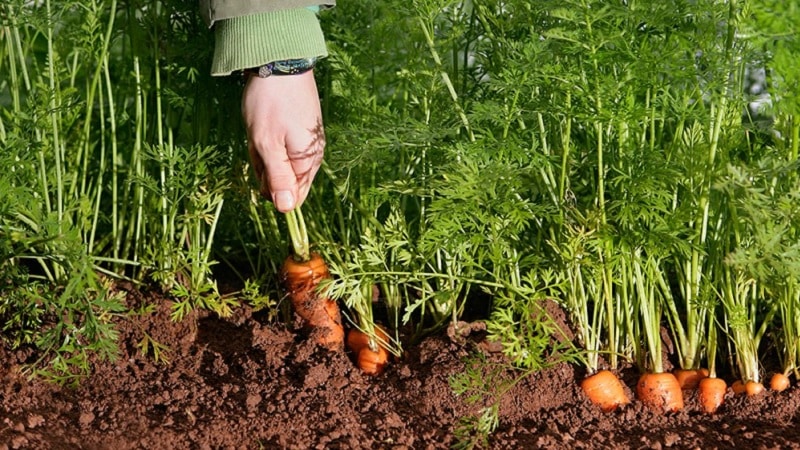Mid-season carrot variety Niiokh 336
The quality and quantity of the harvest of any crop depends not only on its care, but also on the choice of the appropriate variety. Carrots are no exception. For more than 40 years, vegetable growers have been growing the mid-season, high-yielding variety Niiokh 336 in their gardens. Carrots are universal in use and rich in carotene.
Description of the variety
Niiokh 336 is a mid-season carrot variety. It is characterized by high yield and versatility in use: suitable for both conservation and use fresh. It has good keeping quality and can be stored for a long time.

Origin and development
Breeders of the All-Russian Research Institute of Vegetable Growing obtained the variety by crossing Vitamin 6 and Hybrid 5 with subsequent selection. In 1978, Niioh 336 was included in the State Register of the Russian Federation.
The crop is recommended for cultivation throughout the Russian Federation.
Composition and properties
Carrots are rich in beta-carotene, contain a large amount of polyacetylenes, carotenoids (including alpha-carotene and lutein), hydroxycinnamic acids, which have antitumor and anti-inflammatory properties that form an adequate immune response of the body.
Vitamins in root vegetables:
- A (retinol) is found in the form of beta-carotene. Useful for maintaining healthy eyes, skin, growth and boosting immunity.
- H (biotin) promotes the absorption and processing of proteins in the body. Participates in metabolism in the skin.
- B6 (pyridoxine) is involved in growth, blood formation and circulation. Normalizes the functioning of the central nervous system.
- C strengthens the immune system and prevents the development of colds. Has an anti-stress effect.
- E (tocopherol) is involved in protein synthesis and metabolism. Supports the reproductive functions of the body.
- B1 (thiamine) is the most important vitamin for the nervous system. has a positive effect on neuro-reflex regulation.
- B2 (riboflavin) is actively involved in the redox reactions of the body.
Thanks to its high beta-carotene content (23%), carrots have antioxidant properties. Root vegetables reduce the risk of developing cardiovascular diseases and improve vision. Suitable for baby and diet food.
Reference. Vitamin A is a fat-soluble substance, so to absorb it, carrots are consumed along with foods high in fat.
Ripening time and yield
Carrot Niiokh 336 is mid-season - its growing season is 100–120 days. In warm regions, root crops ripen faster, in 80–90 days.
The productivity of the crop is high: 28–54 tons of root crops are harvested from 1 hectare.
Disease resistance
Niiokh is susceptible to the main types of diseases and pests of carrots: brown rot (fomosis), powdery mildew, aphids, mole crickets, carrot flies. Therefore, when planting carrots, the soil and seeds are treated, and preventive measures are taken during cultivation.
Characteristics
Carrot tops are dark green. straight, grows 40–50 cm in height.
The root vegetables are cylindrical with blunt ends, elongated: length - 20-30 cm, width - 4-5 cm. Average weight - 90-110 g. The color of the pulp is bright orange, the core is almost the same shade. The taste is excellent, with a characteristic carrot aroma.
Climatic conditions and growing regions
The Niiokh 336 variety is universal and suitable for cultivation in any region. Resistance to cold climates allows it to be grown even in the Irkutsk, Tomsk, Novosibirsk, Chita and Yakutsk regions. Carrots are drought-resistant.
Advantages and disadvantages
The main advantages of the variety:
- high productivity;
- frost resistance and drought resistance;
- versatility in use;
- good keeping quality;
- excellent taste of root vegetables.
The only drawback is poor resistance to major carrot diseases and pests.
Features of planting and growing
The Niiokh variety is demanding on lighting and soil quality. For a carrot bed, choose well-lit, not over-moistened areas and nutritious soil. The quality of the crop is influenced by previous crops, the frequency of watering and fertilizing.
Preparation

Taking into account the susceptibility of the variety to diseases, planting material is pre-disinfected in a weak solution of potassium permanganate or the preparation “HOM” for 24 hours.
Seeds sold in granule form have already been processed by the manufacturer.
Soil requirements
Heavy, rocky soil is not suitable for growing carrots, since in it the root crops will grow crooked and tasteless, and soil with high acidity. It is best to plant the vegetable in light sandy soil.
Before planting, add humus, dry peat or compost to the soil (4 kg per 1 m2).
Predecessors
To obtain a good harvest, take into account the rules of crop rotation. The best predecessors of carrots:
It is better not to plant root vegetables after dill and parsley: related crops will “reward” Niiokh with weak immunity with new diseases.
Landing dates and rules
The time for sowing carrots depends on the specific region.The optimal time is late spring, when there is no risk of cold snap and sudden frosts. For the middle zone this is the end of April, for Siberia and the Urals - the beginning or middle of May, and for the southern regions - the beginning or middle of March.
Attention! The variety is planted before winter, at the end of October, but at a temperature not lower than +5°C.
After the soil is ready, grooves 1-2 cm deep are made in it, into which the seeds are planted. About 0.5 cm is kept between them. The soil is leveled and thoroughly shed. The plantings are sprinkled with a small layer of peat or humus.
Features of cultivation
At the initial stage, it is difficult to grow carrots: after germination, the beds are regularly weeded, otherwise the weeds will quickly choke out the plantings. To prevent the formation of a crust that interferes with the growth of seedlings, the soil is carefully loosened. Water the crop as the top layer of soil dries.

Watering mode
It is better to water in the morning or evening so that the moisture is absorbed and not evaporated from the sun's rays. The frequency of watering depends on weather conditions. On average, the beds are irrigated once every 4–7 days. Excess liquid promotes the appearance of pests.
Attention! Water carrots between the rows, and not at the root.
Thinning and weed control
Carrots are thinned out 2 times during the entire growing season: 2 weeks after sowing and 3 weeks after the first time. This is done very carefully, since when the root is touched, the carrot produces a new shoot at the site of the break, as a result of which it grows horned and crooked.
Top dressing
Without feeding carrots, it will not be possible to obtain the desired harvest, so nitrogen or potassium fertilizers are applied during the period of active growth.
During the entire growing season, plantings are fed 3 times:
- during the period of growth and development of seedlings, superphosphate is added (5 g per 1 liter of water);
- at the flowering stage, potassium nitrate is used (3 g per 1 liter of water);
- When fruiting, ammonium nitrate is used (3 g per 1 liter of water).
Organics are not used as fertilizer, because carrots do not tolerate fresh manure.
Disease and pest control
Despite the preventive measures taken, diseases appear with improper care:
- When affected by brown rot, gray-brown spots form on the stems, and voids appear in the root crops. For treatment, a solution of colloidal salt is used.
- The Regent fungicide is suitable for powdery mildew, the sign of which is a gray-white coating on the tops.
Main pests:
- Aphids - small insects that accumulate on the stems and petioles of carrots. Oxychom is used against them.
- Carrot flies. When they appear, the leaves begin to turn yellow and dry out for no apparent reason, and the roots rot. Insecticides “Aktellik” and “Aktara” are effective in pest control.
- Medvedki. Signs of appearance are similar to previous pests. Bordeaux mixture and eggshells spread between the rows help a lot.
Difficulties in growing

The main problems when cultivating the variety:
- Yellowing and weakening of seedlings. A possible reason is the presence of pests. In this case, the plantings are treated with Aktara or Ecogel.
- The carrots are cracking. Often the problem is caused by excess moisture.
- Crooked root vegetables. Carrots are deformed in heavy rocky soil, so river sand, sawdust or other leavening agent are added to such soil. Other reasons are improper watering and fertilizing regimes.
- Vegetables grow small. This is facilitated by insufficient moisture, lack of light or untimely thinning.
Harvest and storage
Carrots are harvested taking into account climatic conditions during the growing season.If the weather was cold and rainy, do this in September; if autumn is warm and dry, harvesting is delayed until October–November. Root vegetables are dried and stored in a dry room.
How and when to collect
The Niiokh 336 crop is harvested before the onset of autumn cold, focusing on the yellowing of the tops. This is done on a dry and warm day, since harvesting in cold, damp weather reduces the shelf life of vegetables. After the root vegetables are dried, remove the tops.
Storage features and shelf life
Niiokh has good shelf life, but the shelf life of the crop also depends on the quality of the root crops, so before storing them they are carefully inspected for damage. To improve shelf life, vegetables are placed in boxes with sand, sawdust or sprinkled with chalk. The storage room should not be humid, too cold or warm. The optimal temperature is 0…+5°C.
Advice from experienced gardeners
Vegetable growers who already have experience in cultivating the Niiokh 336 variety are advised to loosen the prepared soil a week before planting the vegetable and disinfect it with a solution of copper sulfate (1 tbsp per 1 tbsp of water), and after sowing, cover the bed with a dark film. This will retain heat and moisture and protect plants from pests.
Reviews
Farmers like the quick ripening of the crop, the appearance and taste of vegetables.
Maria, Moscow: «If you sow several varieties of carrots, Niiokh 336 will stand out with its larger tops and richer bright green color. When you start to pick up carrots, the roots are already the size of your finger, while other varieties are like mouse tails.”
Tatiana, Sarapul: “I liked the Niioh 336 carrots. Smooth and tasty. Keeps for a long time."
Conclusion
Niiokh 336 is a mid-season carrot variety, characterized by smooth, tasty root crops, versatility in use, excellent keeping quality and ease of care. The frost-resistant and drought-resistant crop is suitable for cultivation in all regions of Russia. The only drawback is the average immunity to major diseases and pests. Therefore, to obtain a harvest, it is important to carry out preventive measures throughout the growing season.